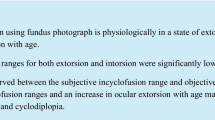Abstract
Purpose
Post-rotatory nystagmus has been used to detect autism spectrum disorders in clinical settings. Although previous studies have focused on eye movements, they did not evaluate the change in ocular refraction during post-rotatory nystagmus. This study aimed to evaluate the changes in ocular refraction during post-rotatory nystagmus in healthy individuals.
Methods
A total of 34 healthy volunteers (mean age ± standard deviation, 20.9 ± 0.6 years) participated in this study. The ocular refraction during post-rotatory nystagmus was measured using MR-6000 (Tomey Inc.) on quick mode with a sampling rate of 30 Hz under noncycloplegic and cycloplegic conditions. The amplitude of post-rotatory nystagmus was calculated on the basis of the anterior eye images, while the ocular refraction measurements were simultaneously recorded. The accommodative convergence per accommodation ratio was calculated using the heterophoria method. Video oculography was performed to measure the angle of convergence during post-rotatory nystagmus.
Results
The changes in ocular refraction during post-rotatory nystagmus were significantly greater under the noncycloplegic condition than under the cycloplegic condition. The changes in ocular refraction during the post-rotatory nystagmus were significantly and positively correlated with the amplitude of post-rotatory nystagmus under the noncycloplegic condition. The angle of convergence during post-rotatory nystagmus was significantly higher under the noncycloplegic condition than under the cycloplegic condition. The changes in the angle of convergence were significantly and positively correlated with the predicted accommodative convergence.
Conclusions
These findings suggest that the accommodation was functional during the post-rotatory nystagmus to compensate for the retinal image slip, and the accommodative convergence can help weaken the nystagmus.









Similar content being viewed by others
Data availability
The data that support the findings of this study are available from the corresponding author (Masakazu Hirota), upon reasonable request.
References
Raphan T, Cohen B (2002) The vestibulo-ocular reflex in three dimensions. Exp Brain Res 145(1):1–27. https://doi.org/10.1007/s00221-002-1067-z
Schoene H (1964) On the role of gravity in human spatial orientation. Aerosp Med 35:764–772
Howard IP, Zacher JE, Allison RS (1998) Post-rotatory nystagmus and turning sensations after active and passive turning. J Vestib Res 8(4):299–312
Harrison JA, Bullock MI (1978) Post-rotatory nystagmus in hyperactive children with spatial awareness problems. Aust J Physiother 24(4):173–180. https://doi.org/10.1016/S0004-9514(14)60878-3
Gresty MA, Ell JJ, Findley LJ (1982) Acquired pendular nystagmus: its characteristics, localising value and pathophysiology. J Neurol Neurosurg Psychiatry 45(5):431–439. https://doi.org/10.1136/jnnp.45.5.431
Altman DG, Bland JM (1983) Measurement in medicine—the analysis of method comparison studies. Statistician 32(3):307–317
Bland JM, Altman DG (1999) Measuring agreement in method comparison studies. Stat Methods Med Res 8(2):135–160
Kawamorita T, Uozato H (2014) Natural pupil size and ocular aberration under binocular and monocular conditions. J Comput Sci Syst Biol 7(1):15–19. https://doi.org/10.4172/jcsb.1000133
Katoh A, Hatanaka T, Takeuchi E, Uchida M, Natsume H (2015) Calibration of infrared video-oculography by using bioadhesive phosphorescent particles for accurate measurement of vestibulo-ocular reflex in mice. Journal of Advanced Science 27(3 and 4):11–16
Kwon KA, Shipley RJ, Edirisinghe M, Ezra DG, Rose G, Best SM, Cameron RE (2013) High-speed camera characterization of voluntary eye blinking kinematics. J R Soc Interface 10 (85). doi: ARTN 20130227.1098/rsif.2013.0227
Irsch K (2015) Optical issues in measuring strabismus. Middle East Afr J Ophthalmol 22(3):265–270. https://doi.org/10.4103/0974-9233.159691
Funding
This work was supported by the Japan Society for the Promotion of Science KAKENHI Grant Numbers JP18H04116 (MH), JP19K20728 (MH), JP19K21783 (MH), and 20H04271 (MH). This work was also supported by Charitable Trust Fund for Ophthalmic Research in Commemoration of Santen Pharmaceutical’s Founder (MH) and Takeda Science Foundation (MH).
Author information
Authors and Affiliations
Contributions
MH and TH contributed to conception and design. MH, RT, CO, KK, RN, and KS acquired data. MH and RT analyzed and interpreted data. MH drafted the article or revised it critically for important intellectual content. MH, RT, CO, KK, RN, KS, and TH gave final approval of the version to be published and agreement to be accountable for all aspects of the work in ensuring that questions related to the accuracy or integrity of any part of the work are appropriately investigated and resolved.
Corresponding author
Ethics declarations
Conflict of interest
Not applicable.
Consent to participants
Written informed consent was obtained from all participants after the nature and possible risks of the study were explained to them. This investigation was conducted in accordance with the tenets of the World Medical Association Declaration of Helsinki. The experimental protocol and consent procedures were approved by the Institutional Review Board of Teikyo University (approval no. 19-173).
Consent to Publish
All authors agree with the latest manuscript before publibcation.
Additional information
Publisher's Note
Springer Nature remains neutral with regard to jurisdictional claims in published maps and institutional affiliations.
Supplementary Information
Below is the link to the electronic supplementary material.
Supplementary file1 (MP4 953 kb)
Supplementary file1 (MP4 984 kb)
Rights and permissions
About this article
Cite this article
Hirota, M., Takigawa, R., Okabe, C. et al. Refractive changes with post-rotatory nystagmus in healthy individuals. Int Ophthalmol 42, 559–573 (2022). https://doi.org/10.1007/s10792-021-02028-0
Received:
Accepted:
Published:
Issue Date:
DOI: https://doi.org/10.1007/s10792-021-02028-0




